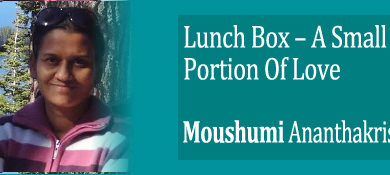T.V. Dinners: A Whole New Connotation!
The TV dinner has its origin in The United States Of America in the 1950s, after World War Two. Many women had entered the workforce just then and were often short of time to cook meals. An innovative company discovered there was a market for a pre-packaged, complete, frozen meal. It consisted of a main course and side dishes, desserts were added later.
One theory why it was called a TV dinner was that the design of those early aluminium trays, to be popped into traditional ovens, resembled the design of the television sets of those days, right down to the TV dials corresponding to its compartments. The other popular theory was that families, tired after a long day, used to have this ready to eat meal clustered around the television set, a novelty in those days in America.
Cut to the 21st century in India. Visit many a home at dinner time and even at many parties held at homes, where you might have been invited and you will see an identical scenario. Little toddlers of one, two and three, and children of four, five and six are being (force) fed around the television set. This is the Indian version of a ‘TV dinner’!
The images flashing on the screen are the focal point and the child is being urged to open his or her mouth, which he or she usually does, like an obedient little birdie! He doesn’t see and barely tastes what he is eating. In some homes, the traditional television has been replaced by cartoons on Youtube on the laptop or on the iPad, even as the child merely swallows food, as this surely cannot be called ‘eating’! The parents are, more often than not, quick to inform you that the child in question NEVER eats unless a particular channel or a certain show is on…
Remember it is we who train a child. It is easy to switch on the TV at meal times and it becomes a habit before you can even blink, but if we or the caregivers put in a bit of effort, a child can be taught to feed himself or herself starting as early as one year. I’ve been there and done that with both my children. A high chair that meets safety standards or a booster chair or a small plastic table and chair, as the child goes older, placed right next to the main dining table, suits this purpose admirably. For very young children, we just need to make bite sized pieces, mix the lentils with the rice and remain at hand at all times in case the child puts in too much at a time and starts choking.|
After all, food sustains your child’s body and helps him to grow and this is just the right time to make children develop a healthy and life long relationship with food. Let her feel the textures with her own hands while you point out the ‘red’ tomatoes, the ‘orange’ carrots, the ‘yellow’ daal. Let her maneuver the spoon into her own little mouth, never mind if half of it falls down on the way there. A mess can be cleaned up quickly later, a bad habit will take much longer to obliterate!
I agree many children need to be distracted slightly while eating. But surely not by the TV set. This is a great time to tell your baby tiny tales, may be from your own childhood or from their own short one! If you have no objection to reading out to the child during meals, then do so! This will inculcate a healthy interest in books instead of television. Often a child who can’t read by himself yet, will urge you to continue, even after the meal is over! If someone else supervises your child during meals, make it clear television is not an option during meals and believe me, you will not regret in the long run…
Most regions of India have delightful tales which tie in neatly with the food being served on a particular day. For example, Maharashtra has the old woman who travels in a pumpkin on the way back from her daughter’s house, in order to avoid being gobbled up by a hungry tiger. That healthy orange pumpkin sabji will go down so much faster during this tale, than during an unrelated cartoon they are watching for the hundredth time.
Also describing how hungry the tiger is, with no food to eat, does make kids chomp a morsel quicker, besides building a super vocabulary. He was starving, he was famished, he was weak with hunger, his stomach was growling… you get the idea! This can be done in any language that you are using with your child, or even in multiple languages. If you do not remember any food folktales from your childhood, ask your parents or in laws. They will be delighted to refresh your memory.
Do not make the mistake of telling your child, as I did one particular day, when I thought my son wasn’t eating enthusiastically enough, that there are many hungry children out there who would appreciate the meal that had been served to him. My then three year old was quick to push his plate towards me and say, ‘Give it to those children then, because I don’t want it!’
Relate instead, the story of the farmer who ploughs the field, pops in a seed (make it chickpeas, horse gram, peas or any lentil or vegetable you are serving that day), waters it, down goes the root, out comes a shoot to meet the sun and then a shy little leaf peeps out. Yes, you just managed to teach your toddler the germination of a seed, even as he/she ate up the entire serving, with so much less reluctance! Now when real life is so interesting, who needs those TV dinners for children? Let’s not give it a new Indian connotation and let it only mean pre-packed frozen meals!
Yes, you have to talk a lot to keep them on track during meals in the early years. Yes, it takes humongous efforts. But all too soon, they will be teenagers and they will resort to replying with monosyllabic grunts to everything you say. And then, before you know it, they will be eating soulless food cooked by strangers, in a hostel mess. So make the most of it while you can and do not let television serials do your job!
Meet Anupama – An archaeologist by qualification, an educational entrepreneur by profession, a linguist by inclination, a writer by vocation! I am a mother of an eleven year old son and a seventeen year old daughter. Currently based in Kenya due to my husband’s job, I manage my Academy in my home town Pune from across the ocean and continue teaching on Skype. To know about my life in Nairobi, memories from India and anything and everything that touches a chord with me, do read my blog: www.kenyankronikals.blogspot.com


